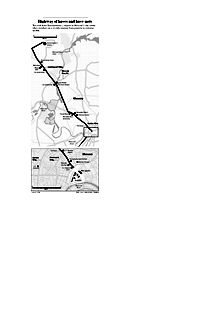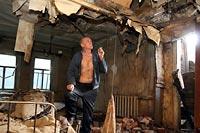Highway to Moscow shows road to riches — and ruin

Tired travelers heading downtown after arriving at Sheremetyevo 1 airport probably don't pay much attention to the village-style wooden houses, set behind picket fences and painted in fading shades of green and blue, that line the busy highway.
One home on this down-at-the-heels stretch of road is where Viktor Zhivin, a 71-year-old retired road worker, was born and grew up. The roof has collapsed over one corner of the house, making half of it uninhabitable. There is no running water, no plumbing, no central heating or piped-in gas, and in winter Zhivin's family burns coal in a stove to fight the bitter cold.
"It's like we're lost in Siberia," he said. "The only advantage is, shops are close. But you need money to go to shops."
Capitalism has transformed Moscow over the past decade, but Zhivin and many others feel they have been left behind. To make the bumper-to-bumper drive from the countryside around this airport to the city center is to take a 21-mile tour of haves and have-nots, a highway as microcosm of the nation.
Start to finish
The route starts out past open fields and birch forests, passes poor rural homes more fitting to a dying mountain village than Europe's largest city, and ends with some of the most expensive shops in the world just a few hundred feet from the Kremlin.
Zhivin's and his wife's pensions total $290 a month, and like millions of other Russians left out of the new prosperity, they are bitter to be so poor amid so much ostentatious consumption.
Despite the frenetic new development and refurbishing of old buildings that has engulfed much of the Russian capital, this patch of rural poverty hasn't been bulldozed because long-term plans for building something else here have never gotten off the ground.
Decades ago, Communist authorities "wouldn't allow us to build better houses — not even better outhouses," Zhivin said. "They kept telling us our village was going to be torn down." In 1996, five years after the Soviet Union's collapse, city officials met with residents and showed them plans for an elite residential development.
"They said they would relocate us to apartments in Moscow and they would build houses for richer people on this land," Zhivin said. "That's how they explained why they weren't providing us with tap water and gas. We complained many times, 'We don't have this. We don't have that.' And they said, 'Look, your village will be demolished. That's why you don't have it."'
Two landmarks
Two miles toward downtown from the decrepit Zhivin home stand two landmarks: a memorial marking the spot where the Nazis were stopped in their 1941 assault on Moscow, and right behind it, a huge shopping complex that's a free-market mecca to the city's emerging middle class. This mega-mall boasts a year-round ice-skating rink, a 12-screen theater complex, more than 200 small- to medium-sized shops and five large stores, including an Ikea and an outpost of the French supermarket chain Auchan so big it has lines for 90 cashiers.
Zhivin has a connection with both landmarks: His father died in the battle to defend Moscow, and his grandson works at Auchan.
"This was the main battle front. I remember how soldiers came here and took positions around our house and inside our house, and slept in our house," said Zhivin, who as a 6-year-old remained at the family home throughout the fighting. "I remember when the planes came and bombed, and the soldiers took us into shelters."
Continuing toward downtown from the anti-Nazi memorial, the highway is home to a string of foreign auto dealerships: Toyota, Mitsubishi, Hyundai, Ford, Mazda, Volvo, Jaguar, Land Rover. There are three McDonald's outlets along this strip, an IMAX theater and a Ramstore supermarket, part of a Turkish chain.
Stuck in 10 lanes
In this area the road is known as the Leningrad Highway because in the opposite direction it leads from Moscow to that city, once again called by its Czarist-era name, St. Petersburg. From the airport into Moscow, the highway is eight or 10 lanes for much of its length, but traffic moves slowly, partly because there are many crossroads and stoplights.
Moving toward downtown, the wealth level escalates with the passing miles. Mercedes-Benz, for example, is closer to the center than the other dealerships.
The gap between rich and poor recalls Czarist times. More than two centuries ago, in his book "Journey from St. Petersburg to Moscow," Alexander Radishchev used this same highway as the backdrop for a famous attack on the ills of the imperial era. He fiercely criticized the privileges of the wealthy, serfdom, censorship and lack of democracy.
Echoes of the past
In the 1790 book, Radishchev described a peasants' hut: walls and ceiling covered with soot, cracked wooden floor thick with dirt, cooking stove lacking any chimney, dried animal bladders rather than glass used in the windows. He also mentioned "two or three pots" and added: "Happy the hut if one of them each day contains some watery cabbage soup."
Radishchev — who was exiled to Siberia for 10 years in punishment for this book — contrasted the poverty of peasant life with a parody of a corrupt government official who developed an inordinate taste for oysters.
"Asleep or awake, he thought only of eating oysters," Radishchev wrote. "While they were in season nobody had any rest. ... He would send an order to the office to furnish him a courier at once, to dispatch with important reports to St. Petersburg. Everybody knew that the courier was sent to fetch oysters, but he had his traveling expenses granted anyhow."
No hiding excess
Today's critics speak in remarkably similar terms.
"The closer to the Kremlin, the more the city looks like the capital of the filthy rich," said Igor Korolkov, a commentator with Novaya Gazeta newspaper. "There are signs of embezzlement and corruption everywhere. ... Lavish cars are parked all day long near government offices. They are not even hiding their excesses."
Among the echoes of the long-ago past still visible along the Leningrad Highway is the 18th century Petrovsky Palace. It was built for Catherine II as a place to freshen up on trips from St. Petersburg to Moscow before arriving at the Kremlin. During Soviet times it was used as an air force engineering academy; now the Moscow city government is restoring it as a luxury hotel.
Deluxe units
Another key landmark is the 866-foot Triumf-Palas apartment tower, aimed at the city's nouveau riche. The Triumf-Palas was marketed as the tallest residential block in Europe. Apartments here sold a few years ago — before construction was finished and before a sharp run-up in real-estate prices — for about $450,000 for a 1,600-square-foot unit.
A half-dozen more blocks toward downtown is a Czarist-era church that in Soviet times became the Valery Chkalov Club, a cultural center named after a famous test pilot. Today it is the Imperiya Casino, garish at night with neon lights.
After this, the road's name changes to Tverskaya, itself a change from the Soviet-era Gorky Street, which boasted such institutions as an Intourist hotel and the Friendship Bookstore. Now one finds European brand-name boutiques here, cellphone stores, expensive restaurants, nightclubs, Moscow City Hall and the refurbished Czarist-era Yeliseyevsky gourmet supermarket, boasting floral chandeliers, stained-glass windows, mahogany furnishings and golden trim on its ornate columns and ceiling.
Beggars can also be seen along this stretch — although most Muscovites believe only professionals panhandle in this district, because they must bribe police to avoid being driven away.
Whenever Kremlin officials head straight from the office to Sheremetyevo 1, they traverse this route in reverse, passing right by Zhivin's tumble-down old home shortly before reaching the airport.
"How can the big shots look us in the eye?" Zhivin complained. "How can they not be ashamed to drive past my house? All the authorities, at all levels, they passed my house — and they don't give a damn."
